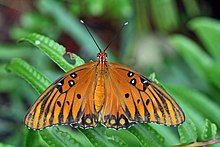| Gulf fritillary | |
|---|---|

| |
| Dorsal view | |

| |
| Ventral view | |
| Scientific classification | |
| Domain: | Eukaryota |
| Kingdom: | Animalia |
| Phylum: | Arthropoda |
| Class: | Insecta |
| Order: | Lepidoptera |
| Family: | Nymphalidae |
| Tribe: | Heliconiini |
| Genus: | Dione Hübner, [1819] |
| Species: | D. vanillae
|
| Binomial name | |
| Dione vanillae | |
| Synonyms | |
|
Papilio vanillae Linnaeus, 1758 | |
The Gulf fritillary or passion butterfly (Dione vanillae) is a bright orange butterfly in the subfamily Heliconiinae of the family Nymphalidae. That subfamily was formerly set apart as a separate family, the Heliconiidae. The Heliconiinae are "longwing butterflies", which have long, narrow wings compared to other butterflies.
Dione vanillae is most commonly found in the southern areas of the United States, specifically in many regions of Florida and Texas.[2]
Gulf fritillaries have a chemical defense mechanism in which they release odorous chemicals in response to predator sightings. As a result, common predators learn to avoid this species.[3] Pheromones play a critical role in male-female courtship behaviors, with male gulf fritillaries emitting sex pheromones that contribute to mate choice in females.[4]
The scientific name Papilio vanillae was given to the gulf fritillary by Carl Linnaeus in 1758, based on a 1705 painting by Maria Sibylla Merian (The Metamorphosis of the Insects of Surinam, Plate XXV), which shows the adult and caterpillar of the gulf fritillary on a vanilla orchid, Vanilla planifolia. However, it is now known that the gulf fritillary caterpillar does not use the vanilla plant.[5] The species was moved to the genus Agraulis in 1835 by Boisduval & Le Conte. A phylogenetic analysis reported in 2019 placed Agraulis as a sub-genus of Dione.[6]
- ^ "NatureServe Explorer 2.0 Dione vanillae Gulf Fritillary". explorer.natureserve.org. Archived from the original on 22 July 2021. Retrieved 3 October 2020.
- ^ Cite error: The named reference
general overview 1was invoked but never defined (see the help page). - ^ Cite error: The named reference
defensive glandwas invoked but never defined (see the help page). - ^ Cite error: The named reference
pheromonewas invoked but never defined (see the help page). - ^ Shapiro, Arthur M., Journal of the Lepidopterists’ Society 62(1), 2008, 58–59.
- ^ Zhang, Jing; Cong, Qian; Shen, Jinhui; Opler, Paul A.; Grishin, Nick V. (5 November 2019). "Changes to North American butterfly names" (PDF). The Taxonomic Report of the International Lepidoptera Society. 8 (2): 5. ISSN 2643-4806. PMC 8570546. PMID 34746798.
